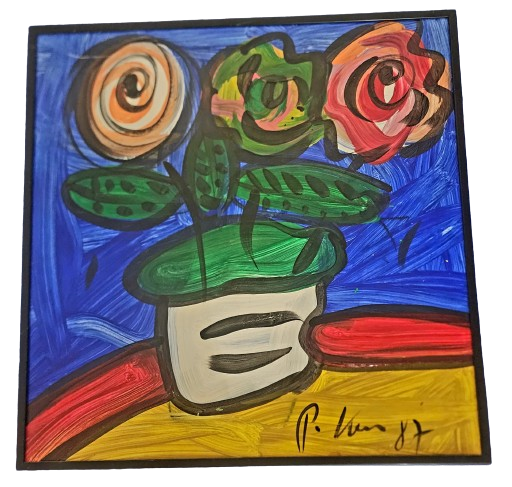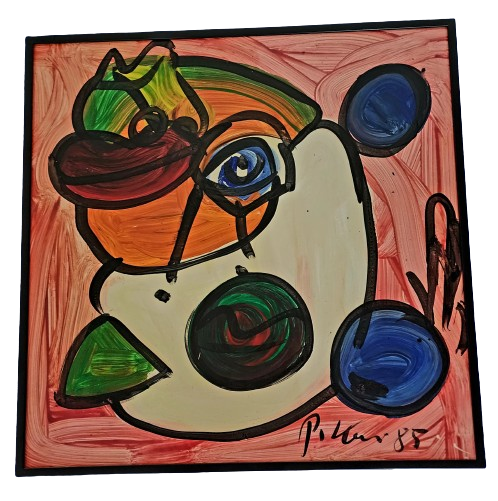
Germany

Peter Keil Flower Bouquet 87 Original Oil Painting by Peter Keil
Flower Bouquet 87 Original Oil Painting by Peter Keil, is one-of-a-kind artwork on a Masonite Panel by The Wild Man of Berlin, a famous contemporary artist. 1987 Signed by Peter Keil & Dated Oil Painting on Masonite Panel Original Artwork Size 24x24. All of Peter Keil's Art Used Thick Paint & Some Paint Flaking May Be Present Due to the Age and Nature of His Work. Painting of Flower Vase Bouquet. Peter Keil's "Flower Bouquet '87": A Celebration of Color and Form "Flower Bouquet '87," a remarkable original oil painting by Peter Keil, showcases the signature style of the artist known affectionately as "The Wild Man of Berlin." Created in 1987 and boldly signed, this 24x24 inch painting on a Masonite panel captures Keil's work's vibrancy and dynamic energy. Known for his thick application of paint, Keil's artistry in this piece displays the potential for texture and dimension within the medium of oil paint. Over time, some of this textural paint has flaked, which is common in Keil's work, lending a historical quality to the painting that chronicles its journey through time. The artwork features a vase of flowers, a classic still-life subject, which Keil reinterprets with his unique blend of expressionism and street art flair. In "Flower Bouquet '87," the traditional theme of the still life is revitalized through Keil's lens, which introduces the exuberant aesthetic of Street Pop Art and graffiti Artwork. The painting eschews subtlety in favor of bold, direct presentation, with flowers rendered in a style that borders the abstract. The whimsical shapes and exaggerated colors speak to the influence of pop art, while the freeform line work and vivid hues echo the raw appeal of graffiti. The artwork serves as a bridge, merging the historically distinct worlds of fine art and urban street art, and invites viewers to engage with the work on a visceral level. The Artistic Merit of Keil's Approach Keil's "Flower Bouquet '87" artistic merit lies in its unabashed celebration of color and form. Keil's work defies the constraints of traditional still-life painting, breathing new life into the genre with his innovative approach. Using Masonite as a substrate reinforces Keil's preference for sturdy, reliable materials that can support his vigorous application of oil paint. The Masonite's smooth surface is the perfect canvas for the thick, sculptural layers of paint, which add depth and complexity to the composition. Furthermore, Keil's painting is a testament to the enduring nature of art. The presence of paint flaking reveals the effects of time yet also highlights the intrinsic beauty found in the natural aging of artwork. This aspect of Keil's work is particularly resonant with the ethos of street and pop art, which often embrace the concept of impermanence and the beauty inherent in decay. "Flower Bouquet '87" does not just depict a scene; it tells a story of its existence through its evolving state. Keil's Legacy in the Fusion of Art Genres "Flower Bouquet '87" is emblematic of Peter Keil's legacy in the fusion of art genres. His approach to the still life reflects a more significant trend in contemporary art of breaking down barriers between high and low culture, between the gallery and the street. Keil's work challenges preconceived notions of fine art, pushing the boundaries of expression and medium. With its energetic brushstrokes and striking palette, this painting is a powerful example of Keil's influence on modern art, particularly within Street Pop Art and graffiti Artwork. Keil's contribution to contemporary art is significant in his stylistic choices and his philosophy towards the creation and consumption of art. He democratizes art by bringing the sensibilities of street art into the gallery space, making it accessible and relatable to a broad audience. "Flower Bouquet '87," as a representation of Keil's oeuvre, underscores the artist's ability to capture the viewer's imagination and to convey emotion through the vibrant language of paint. "Flower Bouquet"'87" stands as a '87" statement to Peter Keil's profound and positive contribution to art. Its textured surface, vibrant colors, and dynamic presence offer a fresh perspective on the still-life genre while honoring the traditions of Street Pop Art and graffiti Artwork. Keil's painting continues to enchant and engage audiences; it reaffirms the artist's place as a significant figure in contemporary art, whose work transcends time and continues to inspire dialogue and passion for the arts.
$587.99

Peter Keil Fish Face Vase 85 Original Oil Painting by Peter Keil
Fish Face Vase 85 is an Original Oil Painting by Peter Keil of a Kind Artwork on Masonite Panel by The Wild Man of Berlin, a Famous Contemporary Artist. 1985 Signed by Peter Keil & Dated Oil Painting on Masonite Panel Original Artwork Size 24x24. All of Peter Keil's Art Used Thick Paint & Some Paint Flaking May Be Present Due to the Age and Nature of His Work—painting of a Highly Abstract Flower Vase. Decoding "Fish Face Vase '85" by Peter Keil "Fish Face Vase '85" emerges as a striking original oil painting on Masonite panel by Peter Keil, an artist colloquially dubbed "The Wild Man of Berlin" for his exuberant and unconventional style. Authenticated with Keil's signature and the date of creation, this 1985 piece unfolds over a 24x24 inch canvas, a testament to Keil's exploration of form and his audacious use of color. The painting presents a highly abstract interpretation of a flower vase, an everyday object transformed through Keil's imaginative lens. As typical of Keil's pieces, the thick application of paint may show signs of flaking, a natural occurrence that adds a layer of authenticity and speaks to the piece's history. In "Fish Face Vase '85," Keil harnesses the visual spontaneity often associated with Street Pop Art and graffiti Artwork. The bold contours and vibrant colors create a composition that borders the surreal, inviting viewers into a world where the conventional vase is seen anew. Keil's interpretation challenges traditional still life, reconstructing it with a playful and abstract quality that resonates with the freedom of expression found in street art. The Artistic Significance of Keil's "Fish Face Vase '85" The artistic significance of "Fish Face Vase '85" lies in its deft fusion of abstract expressionism with the graphic clarity of pop art and graffiti. Keil's approach in this painting is characterized by an intuitive handling of paint, where the medium becomes a vehicle for emotional and visual storytelling. The Masonite panel provides a robust backdrop for the heavy layers of oil paint, a medium that Keil manipulates with confidence and flair. This painting is a prime example of his ability to balance the impulsiveness of street art with the thoughtful composition of fine art. The textural quality of Keil's work, with its thick paint and potential flaking, conveys a sense of timelessness and durability akin to the lasting nature of murals that adorn the urban environment. This piece stands as a dynamic interplay between the ephemeral and the eternal, a concept at the core of graffiti art. "Fish Face Vase '85" captures the essence of this dichotomy, presenting a work anchored in the present yet evolving with time. Keil's Legacy in the Intersection of Art Forms The legacy of "Fish Face Vase '85" within the context of pop, street, and graffiti art is substantial. It symbolizes Peter Keil's innovative spirit and influential role in bridging diverse artistic practices. The painting vividly illustrates Keil's commitment to pushing the boundaries of conventional art forms, infusing them with the energy and vivacity of street art aesthetics. His work is a testament to the power of art to transcend traditional classifications, creating a dialogue that enriches the cultural tapestry of modern art. Moreover, "Fish Face Vase '85" reflects Keil's broader artistic vision, which values accessibility and engagement. His art democratizes the experience of fine art, making it relatable and resonant with a broader audience. With its abstract form and immediate visual appeal, this painting exemplifies Keil's ability to draw in the viewer and provoke a personal and reflective response. "Fish Face Vase '85" is a compelling representation of Peter Keil's artistry, characterized by a bold use of color, an embrace of the textural possibilities of oil paint, and a celebration of the imperfect and the dynamic. The painting is a poignant reminder of Keil's enduring impact on the art world and his status as an artist who effortlessly combines street art's rawness with fine art painting's sophistication. As this piece continues to captivate viewers, it secures Keil's place in the narrative of contemporary art as a visionary who challenges the viewer to see the beauty in the abstract and the everyday.
$587.99



